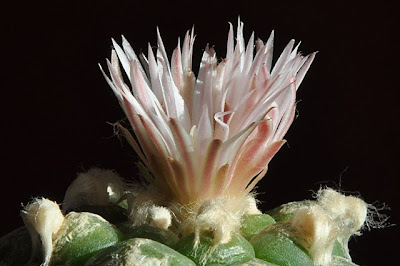
Flowering Lophophora koehresii
My grafted Lophophora koehresii (RS 1182; El Sabino, San Luis Potosí) just flowered for the first time this growing season.
The light pink flower with unusually thin petals having a darker midstripe is true to the species. What appears to be a “double-flowered” variety with extra petals in the picture above is in reality just three flowers unfolding at the same time.

Lophophora koehresii flowers, top view
The Lophophora koehresii scion was badly disfigured by spider mites but managed to outgrow some of the scarring after I started showering my plants regularly and treating them with neem oil – a treatment I intend to continue this year as it seems to be an effective means of controlling the spider mites (and with a bit of luck the plant will outgrow its defacing completely in a couple of years).

Lophophora koehresii disfigured by spider mites
The Trichocereus pachanoi stock plant hosts two different Lophophora koehresii clones (RS 1182; El Sabino, San Luis Potosí), both started from seed March 3, 2007. The first scion was grafted June 7, 2007 and when the Trichocereus pachanoi stock plant grew an offset I grafted another seedling on it May 5, 2008 (the second scion is visible in the foreground of the above picture). I intend to get seeds off this self-sterile species and just need to wait for the second Lophophora koehresii clone to flower before this “all inclusive” graft starts to produce seed ;-)
Bulletin trimestriel de la Société mycologique de France. v. 42 1926
(added: 08/11/2025)
-
*By:*
Société mycologique de France.
*Publication Info:*
Paris :Société mycologique de France.
*Call Number:*
QK1 .S6584
*Contributing Library:*
Missouri...
4 weeks ago



















Red spider mite is a nuissance and most of my Lophophoras got some scarring last year (a particularly nasty one). Is it the tender tissue of the plants or do the mites like to get high? ;)
ReplyDeleteHe, he, that might explain the plants popularity with spider mites ;-)
ReplyDelete